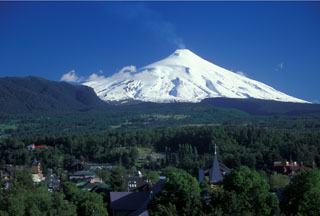Report on Villarrica (Chile) — 22 March-28 March 2023
Smithsonian Institution / US Geological Survey
Weekly Volcanic Activity Report, 22 March-28 March 2023
Managing Editor: Sally Sennert.
Please cite this report as:
Global Volcanism Program, 2023. Report on Villarrica (Chile) (Sennert, S, ed.). Weekly Volcanic Activity Report, 22 March-28 March 2023. Smithsonian Institution and US Geological Survey.
Villarrica
Chile
39.42°S, 71.93°W; summit elev. 2847 m
All times are local (unless otherwise noted)
The eruption at Villarrica was ongoing during 21-28 March. POVI reported that on 21 March Strombolian explosions ejected material 100 m above the crater rim. SERNAGEOMIN reported that at 0551 on 24 March a long-period earthquake was associated with low-intensity crater incandescence. According to POVI a cone with a vent that was about 13 m in diameter had formed on the crater floor and was visible during a recent overflight. Sometimes lava fountains rose over 100 m. At 2249 on 26 March Strombolian explosions ejected incandescent material more than 110 m above the crater rim. The Volcanic Alert level remained at Yellow (the second highest on a four-level scale) according to SERNAGEOMIN. SENAPRED maintained the Alert Level at Yellow (the middle level on a three-color scale) for the communities of Villarrica, Pucón (16 km N), Curarrehue, and Panguipulli, and SINAPRED maintained an exclusion zone of 1 km from the crater.
Geological Summary. The glacier-covered Villarrica stratovolcano, in the northern Lakes District of central Chile, is ~15 km south of the city of Pucon. A 2-km-wide caldera that formed about 3,500 years ago is located at the base of the presently active, dominantly basaltic to basaltic andesite cone at the NW margin of a 6-km-wide Pleistocene caldera. More than 30 scoria cones and fissure vents are present on the flanks. Plinian eruptions and pyroclastic flows that have extended up to 20 km from the volcano were produced during the Holocene. Lava flows up to 18 km long have issued from summit and flank vents. Eruptions documented since 1558 CE have consisted largely of mild-to-moderate explosive activity with occasional lava effusion. Glaciers cover 40 km2 of the volcano, and lahars have damaged towns on its flanks.
Sources: Servicio Nacional de Geología y Minería (SERNAGEOMIN), Proyecto Observación Villarrica Internet (POVI), Sistema y Servicio Nacional de Prevención y Repuesta Ante Desastres (SENAPRED)

